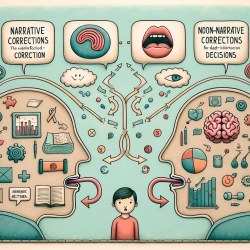Introduction
In the world of speech-language pathology, especially when working with children, the way we communicate and correct misinformation can have profound effects on outcomes. A recent study titled "You don’t have to tell a story! A registered report testing the effectiveness of narrative versus non-narrative misinformation corrections" offers valuable insights into how different formats of information presentation can impact the effectiveness of misinformation corrections.
Understanding the Research
The study, conducted by Ecker et al. (2020), explored whether narrative corrections (story-like formats) are more effective than non-narrative corrections (fact-oriented formats) in reducing the influence of misinformation. The research was conducted across three experiments with a total of 2,279 participants, targeting various types of misinformation, including fictional events and real-world claims.
Interestingly, the study found that narrative corrections were no more effective than non-narrative corrections in reducing misinformation. This challenges the common belief that stories are inherently more persuasive and suggests that the format of correction may not be as crucial as the content itself.
Implications for Practitioners
For speech-language pathologists working with children, this research offers a data-driven approach to correcting misinformation. Here are some practical takeaways:
- Focus on Content: Whether using narrative or non-narrative formats, ensure that the information is accurate, clear, and directly addresses the misinformation.
- Consider the Audience: While the study found no significant difference between formats, individual preferences and comprehension levels may vary, especially in children. Tailor your approach to the child's needs.
- Emphasize Credibility: The study highlights the importance of credible sources in correcting misinformation. Ensure that your corrections are backed by reliable data and evidence.
Encouraging Further Research
While this study provides valuable insights, it also opens the door for further research. Practitioners are encouraged to explore how different formats might impact specific populations, such as children with language impairments or those from diverse cultural backgrounds. Additionally, investigating the long-term effects of different correction formats on memory and comprehension could provide deeper insights.
Conclusion
In conclusion, while narratives can be engaging, this study suggests that the effectiveness of misinformation corrections in speech-language pathology relies more on the content than the format. As practitioners, focusing on delivering clear, accurate, and credible information will likely yield the best outcomes for children.
To read the original research paper, please follow this link: You don’t have to tell a story! A registered report testing the effectiveness of narrative versus non-narrative misinformation corrections.










